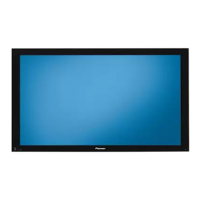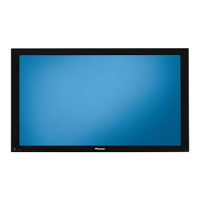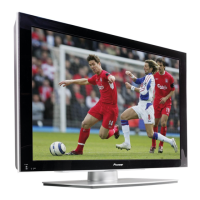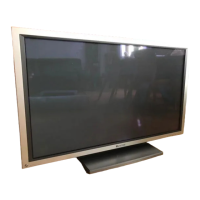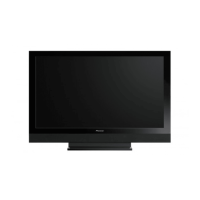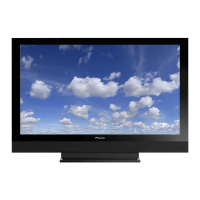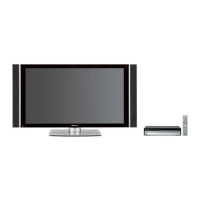
Do you have a question about the Pioneer pdp-506hdg and is the answer not in the manual?
| Screen Size | 50 inches |
|---|---|
| Display Type | Plasma |
| Aspect Ratio | 16:9 |
| Contrast Ratio | 3000:1 |
| Brightness | 1100 cd/m² |
| Viewing Angle | 160 degrees |
| Inputs | HDMI, Component, Composite, S-Video |
| Resolution | 1365 x 768 pixels |
Essential safety advice for operating the system, including risk of shock and environmental considerations.
Details compliance with Federal Communications Commission regulations for digital devices.
Precautions for safe setup, proper air circulation, and preventing overheating.
Information on standby operation and status lights for power control.
Recommendations for long-term display quality and avoiding image retention.
Measures to ensure secure installation and prevent the unit from tipping.
Details on screen protection features and typical pixel behavior.
Information on potential interference from infrared rays and operational sounds.
How to avoid image retention and panel sticking from static images.
Comprehensive safety rules for using and maintaining the product.
Warnings about power sources, cords, and preventing electrical hazards.
Guidelines for professional servicing and using correct parts.
Specific advice for installing the unit securely, including mounting.
Items included with the Plasma Display.
Items included with the Media Receiver.
Locating and identifying parts on the Plasma Display.
Locating and identifying parts on the front of the Media Receiver.
Locating and identifying parts on the rear of the Media Receiver.
Explains the buttons and operation of the remote control.
Guidance on positioning and setting up the Plasma Display.
Guidance on positioning and setting up the Media Receiver.
Instructions for securing the unit to prevent accidental tipping.
Step-by-step connection of the Plasma Display and Media Receiver.
Methods for organizing and securing cables using provided accessories.
Instructions for inserting batteries and handling the remote.
Information on the remote's effective operating range and potential issues.
Guide for connecting an antenna for optimal signal reception.
Instructions for attaching the ferrite core for noise reduction.
Procedures for powering the system on, off, and managing standby mode.
How to select TV channels using the remote or front panel.
Controls for volume level and muting audio output.
Selecting audio modes for different broadcast signals.
Operating 2-screen and picture-in-picture display modes.
Capturing and holding a single frame from a moving image.
Structure of AV and PC mode menus for system settings.
General procedures for accessing and adjusting menu settings.
Guide to using Auto Installation and Auto Search for channels.
Instructions for manually programming TV channels.
Adjusting settings to minimize video noise on channels.
Methods to reduce audio distortion from strong signals.
Enabling and configuring channel lockout features.
Naming channels for easier identification during selection.
Reordering and managing the sequence of tuned channels.
Selecting the on-screen display and Teletext language.
Choosing picture presets based on viewing conditions or content.
Fine-tuning picture settings like contrast, brightness, and color.
Enhancing motion smoothness for film-based content.
Modifying color temperature for optimal white balance.
Enhancing color contour clarity using CTI.
Adjusting specific color components for image tuning.
Reducing video noise using DNR and MPEG NR functions.
Optimizing contrast (ACL) and image gradation (Gamma).
Enhancing picture separation and interlace-to-progressive conversion.
Adjusting audio settings like treble, bass, balance, and focus.
Enabling 3D sound effects and deep bass.
Routing audio from the sub-screen to headphones.
Utilizing Energy Save modes to reduce power consumption.
Configuring automatic standby based on signal or inactivity.
Changing the vertical scan frequency for optimal display.
Auto and manual methods for aligning PC display images.
Selecting the correct color system for clear image display.
Manually setting aspect ratios for different video signals.
Enabling automatic adjustment of aspect ratio based on signals.
Setting preferences for 4:3 signals with Auto Size enabled.
Modifying the brightness of side masks in 4:3 modes.
Setting the system to automatically enter standby mode after a delay.
Procedures for setting, changing, and resetting the system password.
Introduction to Teletext services and how the system receives them.
Turning Teletext on/off and navigating through pages.
How to view multiple subpages transmitted for a Teletext page.
Connecting and displaying video from a DVD player.
Connecting and displaying video from a VCR.
Connecting and viewing content from a digital tuner.
Connecting and viewing images from gaming devices or camcorders.
Connecting and displaying video from a personal computer.
Enhancing audio experience by connecting external sound systems.
Preventing image quality issues by managing monitor outputs.
Connecting digital video and audio sources via HDMI.
Activating HDMI and selecting appropriate signal types.
Linking Pioneer equipment for synchronized control.
Information on SR+ features for linked operations.
Solutions for common issues encountered with the system.
Pinout diagram and signal names for the D-sub connector.
Recommended channel setup selections for various countries.
Technical details and features of the Plasma Display and Media Receiver.
